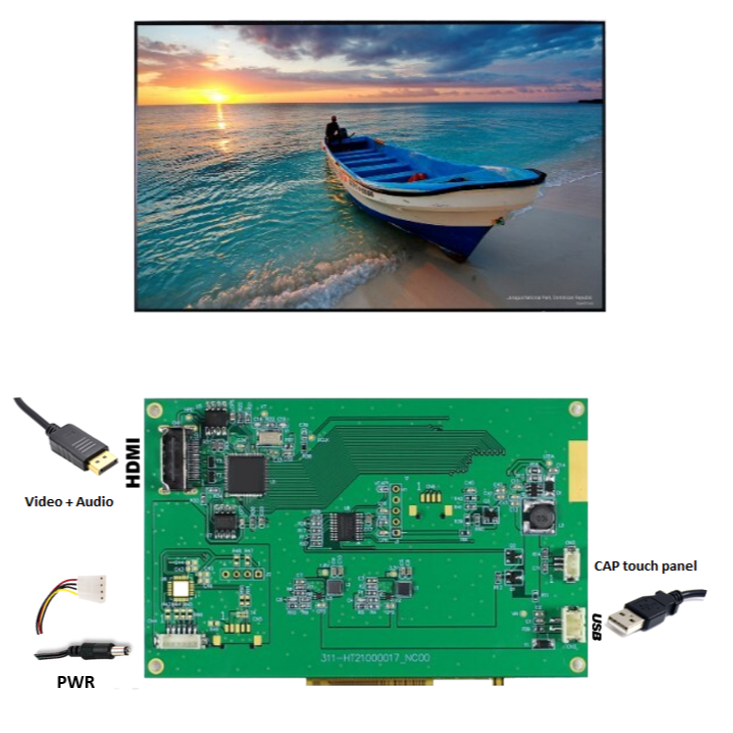
Introduction
In today’s digital age, displays have evolved from their humble CRT origins to sophisticated high-definition screens that grace our living rooms, offices, and gaming setups. Among the many display technologies available, HDMI (High-Definition Multimedia Interface) stands out as a universal standard for connecting our devices to displays, delivering stunning visuals and audio. In this blog, we will explore the wonders of HDMI displays, shedding light on their history, functionality, and the impact they have on our daily lives.
The HDMI Revolution
Before HDMI became the household name it is today, consumers faced a daunting array of connectors, each with its own limitations and drawbacks. HDMI, introduced in 2003, revolutionized the way we connect our devices to displays. It unified audio and video transmission into a single cable, simplifying setups and enhancing performance. The introduction of HDMI represented a massive leap forward in terms of image and audio quality, setting the stage for the transition from standard definition to high definition.
Key Features of HDMI
- High-Resolution Support: HDMI cables and connectors support a wide range of resolutions, from standard definition (SD) to 4K Ultra High Definition (UHD), and beyond. This flexibility ensures that HDMI is the go-to choose for a multitude of devices, from gaming consoles to home theaters.
- Audio and Video in One Cable: HDMI doesn’t just deliver stunning visuals; it also carries high-quality audio, eliminating the need for separate audio cables. This simplifies the setup and ensures synchronized audio and video, a crucial aspect of the home theater experience.
- Deep Color and High Refresh Rates: HDMI is capable of transmitting deep color and high refresh rates, enhancing the visual experience, particularly for gaming and 4K content. High refresh rates offer smoother motion, while deep color provides a more extensive color palette for vivid, lifelike images.
- Compatibility: HDMI is a universal standard, meaning that it is found on most modern devices. This compatibility ensures that you can connect your laptop, gaming console, Blu-ray player, or any other HDMI-enabled device to your display or TV without hassle.
- CEC (Consumer Electronics Control): HDMI includes CEC, allowing for the control of multiple connected devices with a single remote. This simplifies the user experience, making it easy to control your entire entertainment system with a single click.
Applications of HDMI Displays
- Home Theater: HDMI is the backbone of modern home theater systems. It connects Blu-ray players, gaming consoles, sound systems, and projectors to deliver an immersive cinematic experience in the comfort of your home.
- Gaming: Gamers can’t get enough of HDMI displays. The combination of high resolutions, deep color, and high refresh rates makes it the preferred choice for gaming, whether on PC, PlayStation, Xbox, or Nintendo consoles.
- Professional Use: HDMI is not limited to entertainment; it’s also a staple in professional environments. From connecting laptops to projectors in conference rooms to facilitating video editing on high-resolution monitors, HDMI plays a crucial role in the business world.
- Education: In educational settings, HDMI connections are used for interactive whiteboards, digital projectors, and other teaching aids, enabling educators to engage students with multimedia content effectively.
Conclusion
HDMI displays have undoubtedly transformed the way we interact with digital content, whether for entertainment, work, or education. Its remarkable ability to transmit high-definition audio and video through a single cable has simplified our lives and elevated our visual experiences.
As technology continues to evolve, HDMI is keeping pace with advancements such as HDMI 2.1, which supports even higher resolutions, faster refresh rates, and improved gaming features. In the coming years, HDMI is poised to remain a central player in the world of displays, providing us with breathtaking visuals and immersive audio experiences.
So, the next time you connect your laptop to a monitor, fire up your gaming console, or settle in for a movie night, take a moment to appreciate the magic of HDMI displays, which bring the world of digital content to life in all its vibrant glory.
Features of Microtips Technology HDMI Display
Standard HDMI Input
Our HDMI display modules include a full-size HDMI port to plug into Raspberry Pi Single Board Computers (SBCs), PCs, or any windows or Linux media source with an HDMI output.
Rapid and Pain-free Prototyping
Pairing one of our HDMI display modules with a compatible development board is the best way to turn a concept into a reality quickly and without display and touch driver development.
Full RGB Brilliance
With the ability to display up to 16.7 million colors, our HDMI display modules can provide the exact color and look to your products with the full RGB spectrum at your disposal.
Microtips Technology https://microtipsusa.com/ provides local sales and engineering support in the Americas, Europe, and Asia. We are always available to discuss your project and make sure it will be a perfect fit for your needs.
